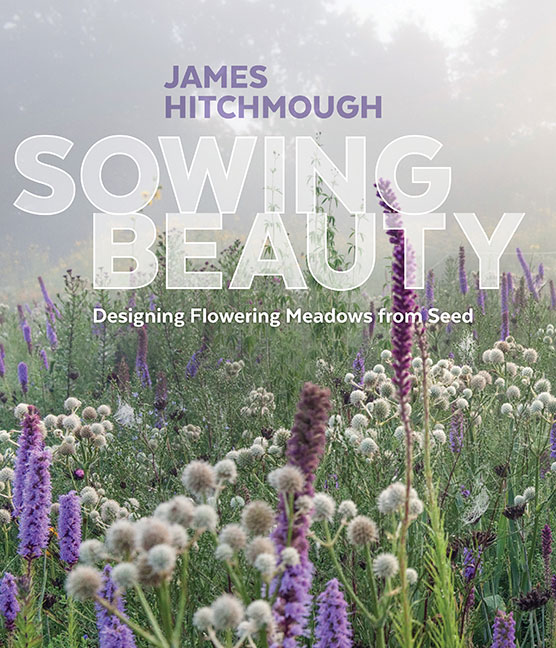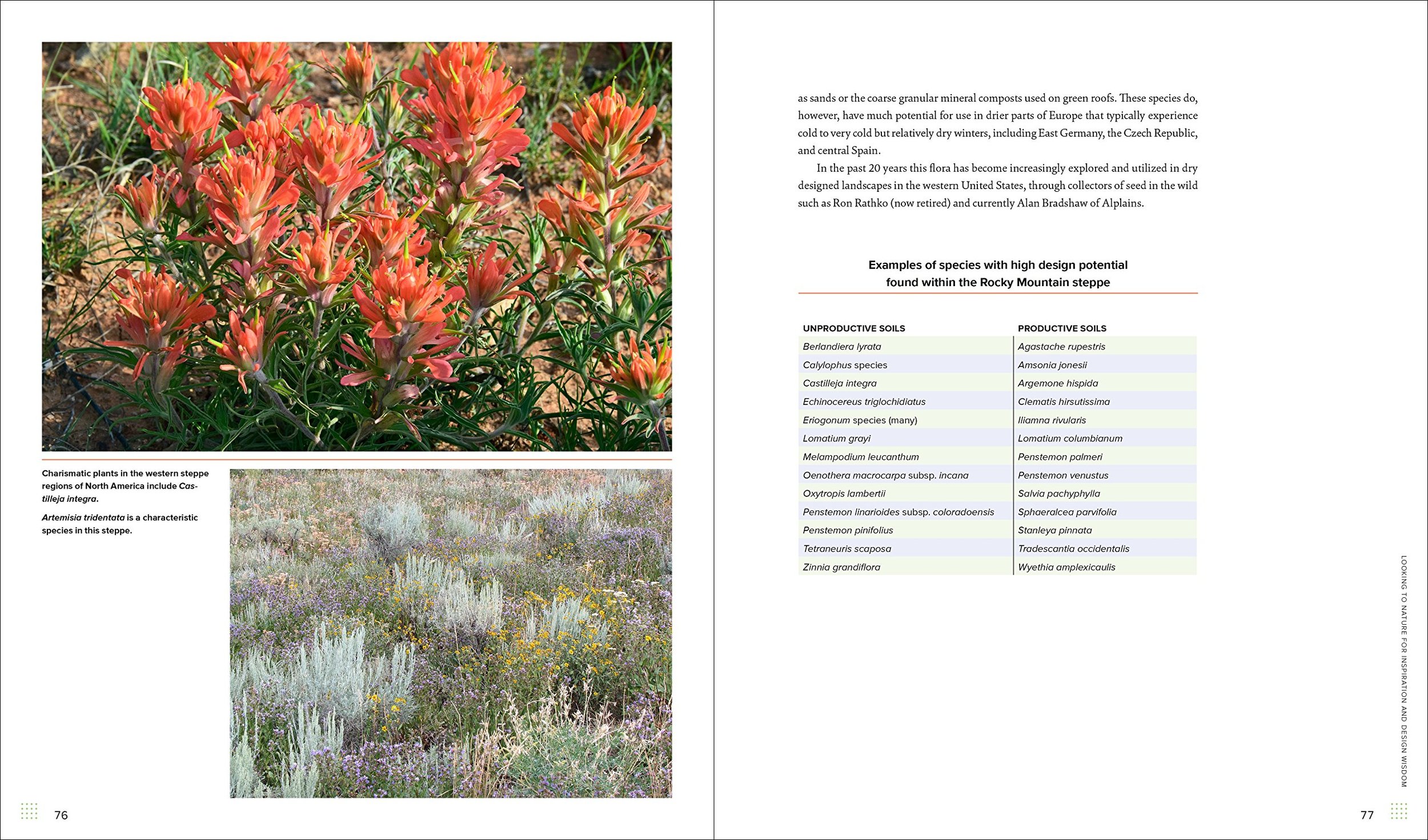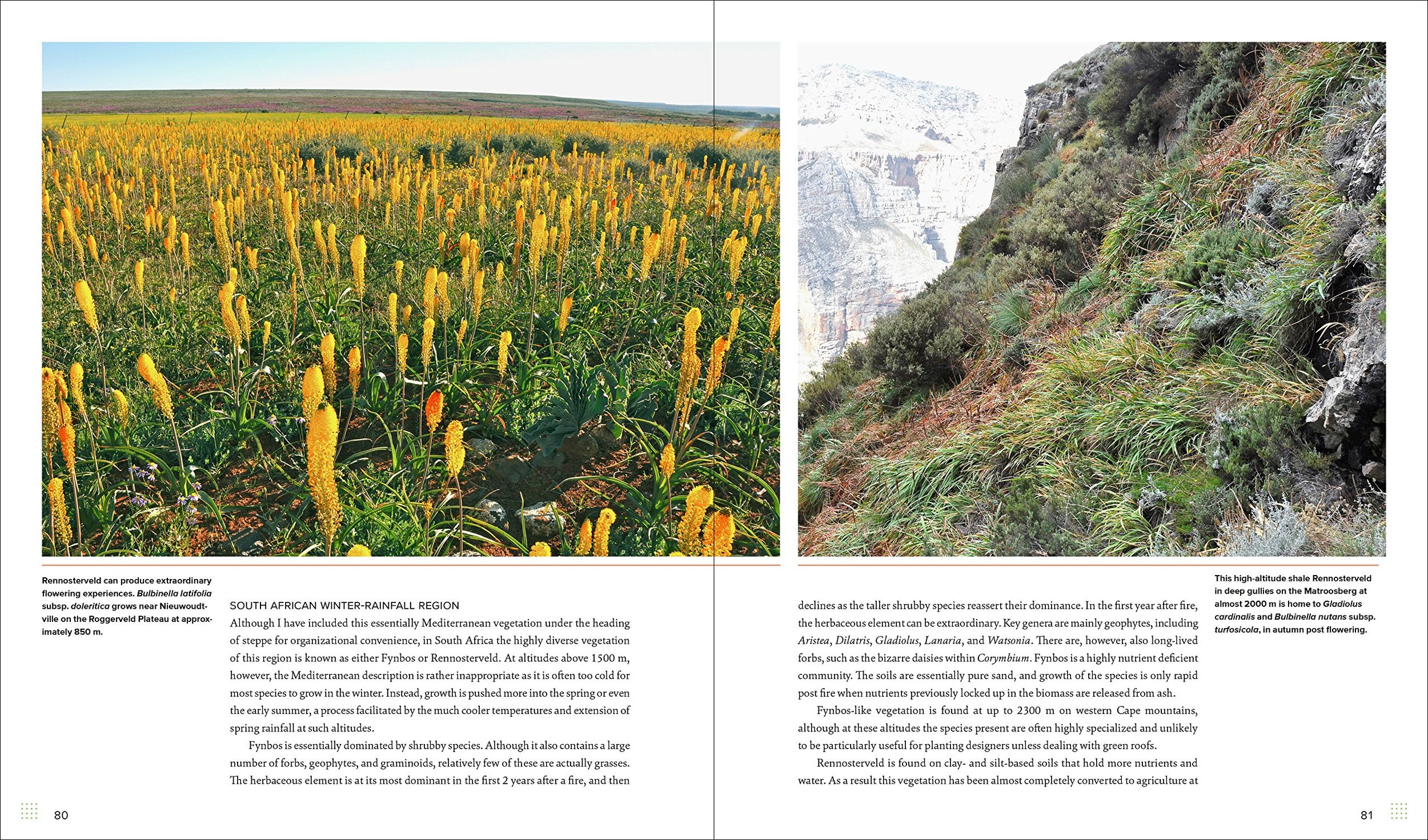Book Review: Sowing Beauty: Designing Flowering Meadows from Seed by James Hitchmough

by Eric Hsu
Together with his colleague Nigel Dunnett whose work at the Barbican Center in London is his most visible work, James Hitchmough have put Sheffield University on the map for their pioneering work in plant communities and their horticultural application in public spaces. While Henk Gerristen, Piet Oudolf, and their peers have respectively publicized the ecological-based tenets of planting for aesthetic effect and lower input than traditional plantings, James Hitchmough, despite being a well-respected researcher and a valued consultant to garden designers like Tom Stuart Smith, has largely been under the radar. Sowing Beauty: Designing Flowering Meadows from Seed (Timber Press 2017) may finally shift the spotlight onto his work. The book is a distillation of more than 30 years of research at Sheffield’s Department of Landscape Architecture. In his introduction, Hitchmough makes it clear that the book is “about utilizing an understanding of how naturally occurring plant communities function ecologically, and then transferring this understanding to help design, establish, and manage visually dramatic herbaceous vegetation in gardens, urban parks, and other urban greenspaces that is long persistent.” In no way are the vegetation he envisages for these plantings are always exact facsimiles of the wild ones, as sometimes he liberally borrows taxa from congruent habitats because seasonal interest must be sustained longer than natural plant communities permit.
 Hitchmough is aware of the native plant debate, recognizing that the inclusion of exotic taxa in his planting may be an affront to those who see the disparity between his lament of the biologically diminished landscape and his appreciation of wild landscapes overseas. For a country whose flora was left less diverse after the Ice Age, United Kingdom would be poorer without its garden flora, much of it introduced during the 19th and 20th centuries. Where would Cornish gardens be without their tree ferns, rhododendrons, and camellias, and how would the herbaceous borders on those palatial estates look with only native plants? Imagine Capability ‘Lancelot’ Brown creating landscape parks without the range of trees. Hitchmough points out that large countries like United States or China benefit from having a large native flora, yet the definition of ‘native’ becomes ambiguous if someone would use species with disparate distributions (East versus West Coast). There is a gulf between the political and ecological definition of what is native, and environmental stressors in urban landscapes may be unsuitable for native species where exotic species may be more resilient. Pollinators do not discriminate between native and exotic taxa as long as nectar and food sources are satisfied. Any concern about invasive species is negligible because these uncooperative species are incompatible with the complex vegetation Hitchmough seeks to create. Conscientious of his work within the political and social-cultural context, he will adapt if native species reflect more accurately of the site than simply having exotics. Whereas Hitchmough’s contemporaries depend heavily on plugs and containerized plants for their work, sowing seeds of the desired species is the crux of Hitchmough’s plantings. The immediate benefit is economical scale-wise since large meadows would have required generous financial expenditure. And there is a magic of seeing the ground once bare become awash with vegetation.
Hitchmough is aware of the native plant debate, recognizing that the inclusion of exotic taxa in his planting may be an affront to those who see the disparity between his lament of the biologically diminished landscape and his appreciation of wild landscapes overseas. For a country whose flora was left less diverse after the Ice Age, United Kingdom would be poorer without its garden flora, much of it introduced during the 19th and 20th centuries. Where would Cornish gardens be without their tree ferns, rhododendrons, and camellias, and how would the herbaceous borders on those palatial estates look with only native plants? Imagine Capability ‘Lancelot’ Brown creating landscape parks without the range of trees. Hitchmough points out that large countries like United States or China benefit from having a large native flora, yet the definition of ‘native’ becomes ambiguous if someone would use species with disparate distributions (East versus West Coast). There is a gulf between the political and ecological definition of what is native, and environmental stressors in urban landscapes may be unsuitable for native species where exotic species may be more resilient. Pollinators do not discriminate between native and exotic taxa as long as nectar and food sources are satisfied. Any concern about invasive species is negligible because these uncooperative species are incompatible with the complex vegetation Hitchmough seeks to create. Conscientious of his work within the political and social-cultural context, he will adapt if native species reflect more accurately of the site than simply having exotics. Whereas Hitchmough’s contemporaries depend heavily on plugs and containerized plants for their work, sowing seeds of the desired species is the crux of Hitchmough’s plantings. The immediate benefit is economical scale-wise since large meadows would have required generous financial expenditure. And there is a magic of seeing the ground once bare become awash with vegetation.
“Looking to Nature for Inspiration and Design Wisdom” addresses the ecological parameters one must consider for successful plant communities in gardens. These parameters include climate, soil types, degree of competition with other plants, and herbivore pressures. Any experienced gardener knows too well the heartbreaking travails of failing to grow plants that fit the climate. While it seems prescriptive to match climatic conditions to the plants that are engineered to thrive, it does save one from meaningless struggles, curtailing any unrealistic expectations. Operating on a sliding scale that can accommodate plants with different levels of climatic fitness may be a preferable approach than the dogmatic of sticking merely to ‘extremely fit’ plants. Unsurprisingly less productive soils generally produce species-rich meadows while rich fertile soils permit rapidly growing species to dominate at the expense of diversity. The morphological architecture of plants can indicate the type of environments they can withstand – large leaves can signal high moisture needs and shade. Hitchmough points out that plant communities possess canopy layering, and one can intuit the general appearance and character from each layer.

Traditional horticulture perspectives doled out in general gardening books can unfairly alter our understanding of garden plants – for instance, well-drained soil, moderate temperatures, and sun are cultivation perquisites for Kniphofia, but when evaluated ecologically, a gradient of different conditions emerges for the various species. The horticultural advice overlooks the possibility of Kniphofia being in drainage swales because it assumes that the plants will be used in planting strictly for visual impact, not ecological sympatry. Hitchmough stresses this distinction because ecological, not necessarily aesthetic, traits of plants are the main priority.
Hitchmough’s valid points come from serious studies during his visits to various plant communities in Eurasia, Western North America, Asia, and South Africa. These communities are described and analyzed for their relevancy to his designs. A major challenge from incorporating some of the plants is slugs, which flourish in the maritime mild climate of United Kingdom. There is an inverse relationship between slugs and altitude – the higher the altitude, the less the slug population. High altitude species are sometimes difficult to incorporate because of the slug pressure. Nonetheless Hitchmough does draw up examples of species with high design potential from the plant communities. Gardeners may already grow some of them; for example, Achillea filipendulina, Alcea rugosa (hollyhock), and Eremurus species are suggested species found on productive soils of the Eurasian steppe. How does one take inspiration by studying plant communities worldwide and translate it for designed versions?
Hitchmough lays out two approaches in ‘Designing Naturalistic Herbaceous Plant Communities’: the biogeographic method and the non-biogeographic, pick and mix route. The former results in a some facsimile of the wild community where the sense of identity is emphasized and the planting more likely sustainable long-term. In contrast, the latter exercises more creative freedom due to the lack of biogeographic constraints. It does require more complex understanding of the plants and their interspecific interactions. Hitchmough even proffers the species level rather than the community approach, although the conditions at the proposed planting site must be approximated first. The well-known plantswoman Beth Chatto has taken this species level methodology in which species sharing similar cultural requirements are grown together. Regardless of which approach one applies to their design, macroclimatic and microclimatic factors must be weighed. Latitude, altitude, and continentality define macroclimatic ones while degree of shade, aspect, soil moisture stress, and soil productivity and pH characterize microclimatic ones. Hitchmough has helpfully organized the environmental and management limitations for various natural meadow-like plant communities and species in a table.
Flowering is categorized interestingly in three ways, dramatic, intermediate and low key, driven by the ratio of foliage to flowers at peak bloom, the size of each flower, and the impact of flower color. Asclepias tuberosa would be dramatic because it elicits the ‘wow’ reaction from people otherwise indifferent to plants. Sanguisorba is considered low-key for its flowers are small and not vividly colorful. It may be easy to be dismissive of these systematic categorization, but a wide gulf exists between the public perception and the trained eye. If designed plant communities need to have the impact in public spaces, sometimes our aesthetic values need realistic reassessment for a dispassionate perspective. It is a telling reminder before design objectives can be formulated.
“Seed Mix Design, Implementation, and Initial Establishment” looks at the intricacies of seed mixes. For those outside the profession, using seed mixes seems a failproof technique of achieving the colorful beautiful displays. However, these mixes are usually made of annual species whose high germination rates and little or no seed dormancy enhances successful results. In contrast, mixes of perennial species are sometimes unreliable because lower germination rates and consequent lower density of seedlings are inherent. Seed quality and storage is the main culprit when one selects species for seed mixes – obscure or rare species tend to have the lowest germinability, leading to intermittent demand and longer storage time. Because assessing seed quality takes considerable expenditure, one must brace for paying higher costs upfront. However, the tradeoff is better viability and less variability, which is less costly than having to repeat orders and contend with erratic germination.
Hitchmough cautions readers not to confuse percentage germination with percentage field emergence. High germination can be offset by mortality in field emergence, the survival rate of seedlings visible to naked eye. What can break or make is soil moisture – seedlings, irrespective from dry or moist habitats, benefit with no or minimal moisture stress. All these factors must be weighed before numbers are made for the seed mixes. The mathematician in the horticulturist may delight at the opportunity to calculate the weight of seed for species for a 288 M2 plot. Hitchmough has provided helpful formulas for breaking down the results. Sometimes to bypass the unpredictable facet of direct seed sowing, one can grow plugs or semi-finished plants. Then the question jumps to the available planting spaces per square metre, but actually ends up the same as sowing. What follows is too unchanged. Site preparation, soil cultivation, and sowing mulches will influence the crucial period of seedling survival and establishment. Even the timing of the sowing has an effect as Hitchmough weighs in species with seasonal preferences. Primroses are best sown spring, but Aconitum prefer early and mid autumn to break deep dormancy. The chapter is rounded by an invaluable compendium of emergence data for different taxa.
The first season of sowing still needs diligent husbandry before anything tangible can be witnessed. “Establishment and Management” advises on this first season and subsequent years. Weeding is paramount to any meadow-like gardens since weeds are energetic opportunists. Hitchmough is adamant about weed control, having once hand-weeded an 800-m2 sowing of the prairie garden at the Sheffield Botanical Gardens in its first season. He discourages fertilizing, a self-defeating tactic unless soil compaction and nutrient deficiency necessitates a nitrogen-only fertilizer. Editing becomes a priority once the plants mature and spread. It is a challenge that involves reviewing and conceptualizing the changes because a certain threshold for density of plants is visually acceptable. This threshold comes down to the specific nature of each herbaceous plant community because climate exerts an inexorable effect on window of growth. Hitchmough lays out the community type (i.e. forb dominated and grass dominated for temperate, forb dominated and geophyte dominated for Mediterranean) because the system is no longer a garden where all species from different communities are simultaneously accommodated.
The last chapter contains several case studies in United Kingdom (one exception being in China). Each project is prefaced by a summary of the plant communities, seed source, client and conditions, project area, and timescale. Hitchmough’s scientific methodology is conveyed in the project descriptions where chronological photographs illustrated his points. It is enlightening to read about the successes and failures of each project because most garden designers do not convey the arduous process, focusing instead on the ‘glamorous’ or ‘soft-sell’ results. Having trained and skilled staff to oversee and maintain these complex plantings is another factor Hitchmough brings up – such plantings are not the simple ‘mow and sow’ variety. However, with the slow erosion of skilled horticulturists, the resiliency of meadow-like plantings may be more advantageous than the traditional schemes, like annual bedding. Hitchmough concedes that no amount of empirical data can accurately predict how successful each plant plays in their ‘designed’ communities as plants being living organisms are forever shifting in their longevity and reproductivity. Instead, what the data can achieve is to minimize the losses and increase the rate of establishment.
Sowing Beauty is Hitchmough’s visceral reaction to the environmental degradation of the mining town he grew up in northern UK. It is possible that the extremes we are frequently experiencing from climate change may mean the gradual decline of conventional gardening ideals. In no way should we wait for an ecological catastrophe larger than Chernobyl nuclear disaster or Exxon Valdez oil spill for our mindsets to change. One may discount the meadow-inspired plantings overwrought imitations of the Real McCoy, but for people whose natural connections are becoming fractured in an urbanized world, they represent a vital connection to nature. Thoreau once said: “We need the tonic of wildness”, and Hitchmough’s work brings not only that ‘tonic of wildness’, but an empathic respect for our planet.






